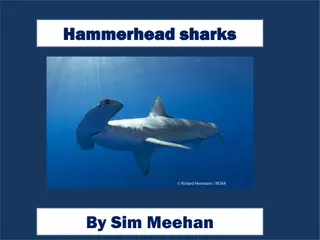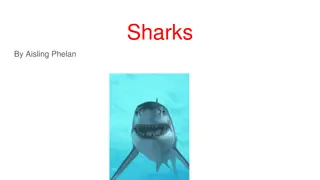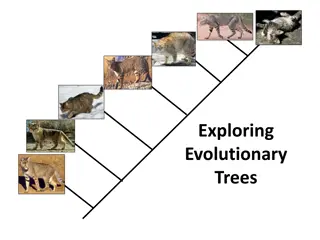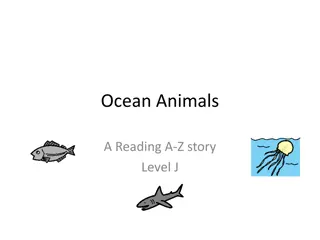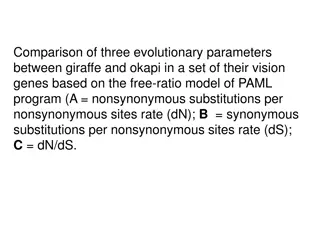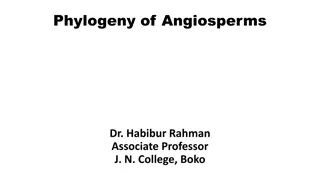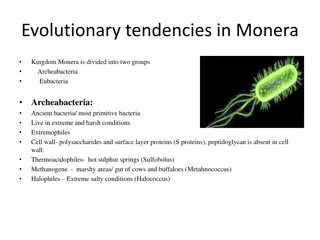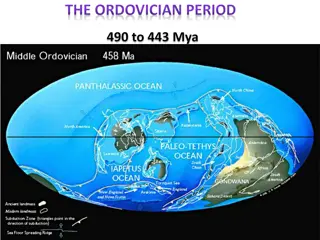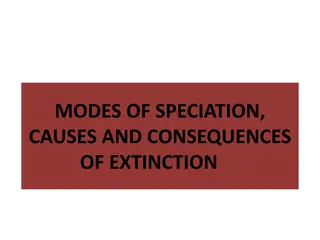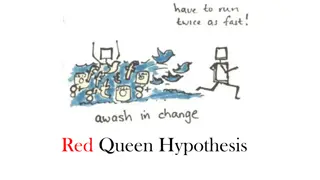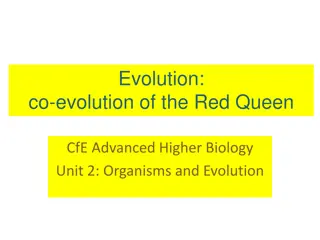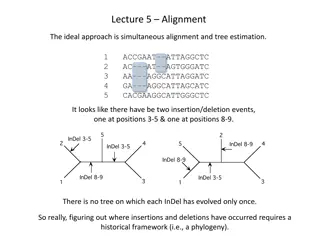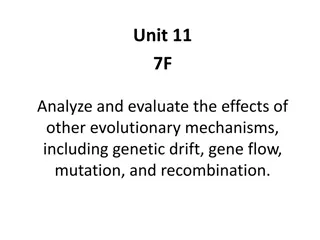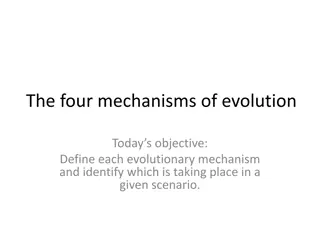Evolutionary History and Characteristics of Sharks
Sharks belong to the Chondrichthyes class and have a long evolutionary history dating back to millions of years. They are efficient predators with unique characteristics like streamlined bodies, gills for underwater respiration, and constantly replaced teeth. Fossil evidence shows the evolution of sharks and their diverse adaptations over time.
Download Presentation

Please find below an Image/Link to download the presentation.
The content on the website is provided AS IS for your information and personal use only. It may not be sold, licensed, or shared on other websites without obtaining consent from the author. Download presentation by click this link. If you encounter any issues during the download, it is possible that the publisher has removed the file from their server.
E N D
Presentation Transcript
Kingdom: Animalia Phylum: Chordata Class: Chondrichthyes Subclass: Elasmobranchii Infraclass: Euselachii Superorder: Selachimorpha
A shark has fins and a streamlined body that help it swim through water. It has gills, which take in oxygen directly out of the water. Because of its gills, sharks can stay underwater and not have to come to the surface to breathe. Sharks also have a tremendous number of sharp teeth, which make them fierce predators.
440 . 30 . . . . . . , . , . . . . 15 , 5 .
Evidence for the existence of sharks dates from the Ordovician period, 450420 million years ago, before land vertebrates existed and before a variety of plants had colonized the continents.[2]Only scales have been recovered from the first sharks and not all paleontologists agree that these are from true sharks, suspecting that these scales are actually those of thelodont agnathans.[11]The oldest generally accepted shark scales are from about 420 million years ago, in the Silurian period.[11]The first sharks looked very different from modern sharks.[12]At this time the most common shark tooth is the cladodont, a style of thin tooth with three tines like a trident, apparently to help catch fish. The majority of modern sharks can be traced back to around 100 million years ago.[13]Most fossils are of teeth, often in large numbers. Partial skeletons and even complete fossilized remains have been discovered. Estimates suggest that sharks grow tens of thousands of teeth over a lifetime, which explains the abundant fossils. The teeth consist of easily fossilized calcium phosphate, an apatite. When a shark dies, the decomposing skeleton breaks up, scattering the apatite prisms. Preservation requires rapid burial in bottom sediments. Among the most ancient and primitive sharks is Cladoselache, from about 370 million years ago,[12]which has been found within Paleozoic strata in Ohio, Kentucky, and Tennessee. At that point in Earth's history these rocks made up the soft bottom sediments of a large, shallow ocean, which stretched across much of North America. Cladoselache was only about 1 metre (3.3 ft) long with stiff triangular fins and slender jaws.[12]Its teeth had several pointed cusps, which wore down from use. From the small number of teeth found together, it is most likely that Cladoselache did not replace its teeth as regularly as modern sharks. Its caudal fins had a similar shape to the great white sharks and the pelagic shortfin and longfin makos. The presence of whole fish arranged tail-first in their stomachs suggest that they were fast swimmers with great agility.
Shark teeth are embedded in the gums rather than directly affixed to the jaw, and are constantly replaced throughout life. Multiple rows of replacement teeth grow in a groove on the inside of the jaw and steadily move forward in comparison to a conveyor belt; some sharks lose 30,000 or more teeth in their lifetime. The rate of tooth replacement varies from once every 8 to 10 days to several months. In most species, teeth are replaced one at a time as opposed to the simultaneous replacement of an entire row, which is observed in the cookiecutter shark.[25] Tooth shape depends on the shark's diet: those that feed on mollusks and crustaceans have dense and flattened teeth used for crushing, those that feed on fish have needle-like teeth for gripping, and those that feed on larger prey such as mammals have pointed lower teeth for gripping and triangular upper teeth with serrated edges for cutting. The teeth of plankton-feeders such as the basking shark are small and non-functional.[26]
Skeleton Shark skeletons are very different from those of bony fish and terrestrial vertebrates. Sharks and other cartilaginous fish (skates and rays) have skeletons made of cartilage and connective tissue. Cartilage is flexible and durable, yet is about half the normal density of bone. This reduces the skeleton's weight, saving energy.[27]Because sharks do not have rib cages, they can easily be crushed under their own weight on land.[28] Jaw The jaws of sharks, like those of rays and skates, are not attached to the cranium. The jaw's surface (in comparison to the shark's vertebrae and gill arches) needs extra support due to its heavy exposure to physical stress and its need for strength. It has a layer of tiny hexagonal plates called "tesserae", which are crystal blocks of calcium salts arranged as a mosaic.[29]This gives these areas much of the same strength found in the bony tissue found in other animals. Generally sharks have only one layer of tesserae, but the jaws of large specimens, such as the bull shark, tiger shark, and the great white shark, have two to three layers or more, depending on body size. The jaws of a large great white shark may have up to five layers.[27]In the rostrum (snout), the cartilage can be spongy and flexible to absorb the power of impacts. Fins Fin skeletons are elongated and supported with soft and unsegmented rays named ceratotrichia, filaments of elastic protein resembling the horny keratin in hair and feathers.[30]Most sharks have eight fins. Sharks can only drift away from objects directly in front of them because their fins do not allow them to move in the tail-first direction.[28]
Sharks are heavy fishes, possessing neither lungs nor swim bladders (see fish ). Their skeletons are made of cartilage rather than bone, and this, along with large deposits of fat, partially solves their weight problem; nevertheless, most sharks must keep moving in order to breathe and to stay afloat. They are good swimmers; the wide spread of the pectoral fins and the upward curve of the tail fin provide lift, and the sweeping movements of the tail provide drive. Their tough hides are studded with minute, toothlike structures called denticles. Sharks have pointed snouts; their crescent-shaped mouths are set on the underside of the body and contain several rows of sharp, triangular teeth. They have respiratory organs called gills , usually five on each side, with individual gill slits opening on the body surface; these slits form a conspicuous row and lack the covering found over the gills of bony fishes. Like most fishes, sharks breathe by taking water in through the mouth and passing it out over the gills. Usually there are two additional respiratory openings on the head, called spiracles. A shark's intestine has a unique spiral valve, which increases the area of absorption. Fertilization is internal in sharks; the male has paired organs called claspers for introducing sperm into the cloaca of the female. Members of most species bear live young, but a few of the smaller sharks lay eggs containing much yolk and enclosed in horny shells. Compared to bony fishes, sharks tend to mature later and reproduce slowly.


